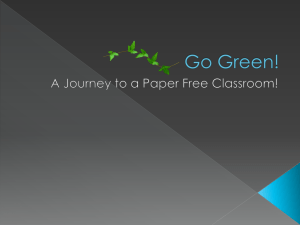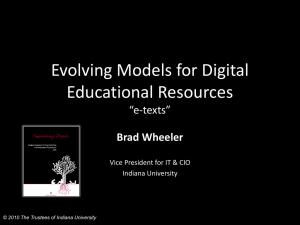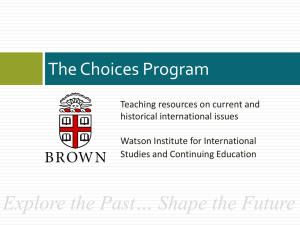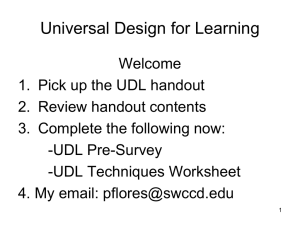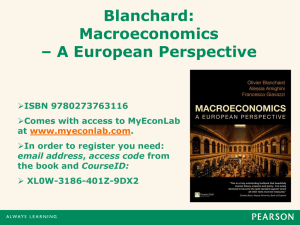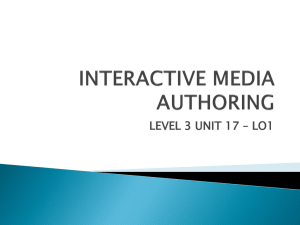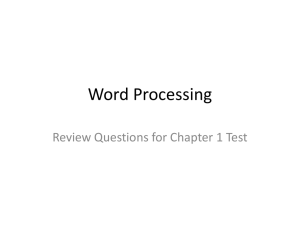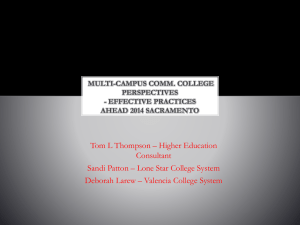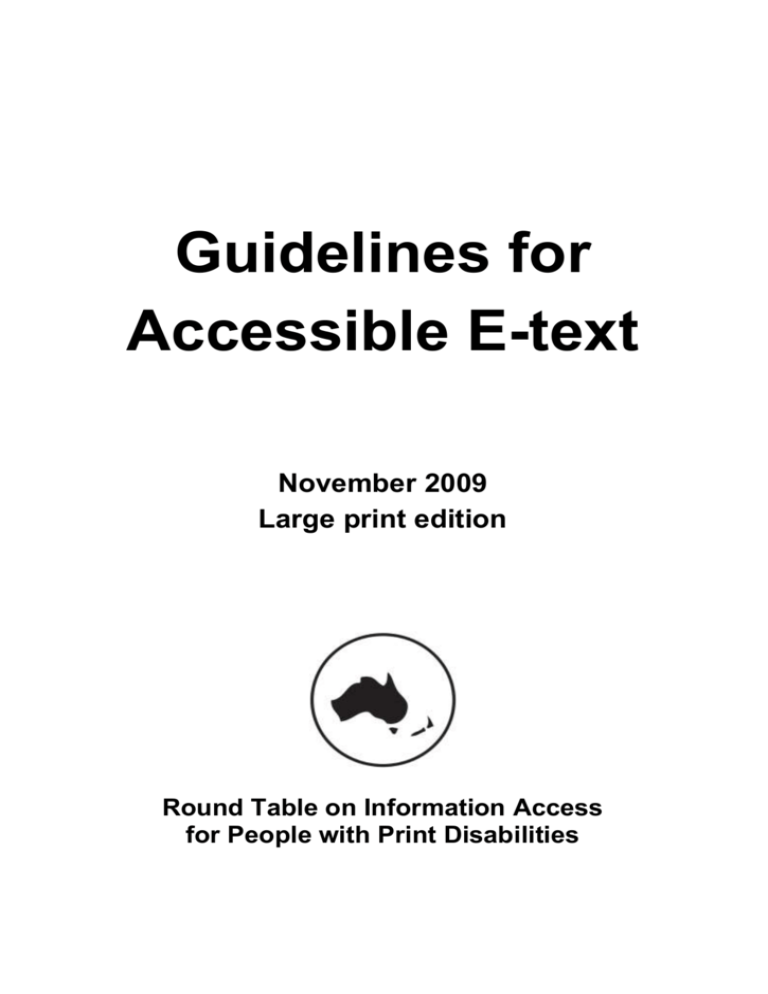
Guidelines for
Accessible E-text
November 2009
Large print edition
Round Table on Information Access
for People with Print Disabilities
Guidelines for Accessible E-text
Copyright © 2009 Round Table on Information Access for
People with Print Disabilities
All rights reserved. No part of this publication may be
reproduced, stored in a retrieval system, or transmitted in
any form or by any means – electronic, mechanical,
photocopying, recording, or otherwise – without prior
permission of the publishers and copyright owner.
Published by Round Table on Information Access for
People with Print Disabilities Inc.
PO Box 229
Lindisfarne, Tasmania 7015
Email: RoundtableAdmn@bigpond.com
Web address: http://www.e-bility.com/roundtable/
Notes about this large print edition
Main text is in Arial typeface, 18 point.
Page numbers from the original print edition are indicated
as follows:
1
National Library of Australia Cataloguing-inPublication entry for original print version
Author: Round Table on Information Access for People
with Print Disabilities.
Title: Guidelines for accessible e-text / Round Table on
Information Access for People with Print Disabilities.
ISBN: 9780980706406 (pbk.)
Subjects:
People with disabilities--Services for.
Electronic publications--Handbooks,
manuals, etc.
Dewey Number: 362.4
About these guidelines
These guidelines are published by the Round Table on
Information Access for People with Print Disabilities Inc.
The Round Table is an umbrella organisation which brings
together producers, distributors and consumers of
information in alternative formats to print; blindness
agencies, tertiary institutions and government departments
in Australia and New Zealand.
These guidelines are available from Round Table in
accessible formats.
Acknowledgements
Compiled by the E-Text Working Party of the Round
Table.
Members of the Working Party:
Jane Wegener, Vision Australia (Working Party leader)
Moira Clunie, Royal New Zealand Foundation of the Blind
Peter Le, Vision Australia
Kathy Riessen, South Australian School for Vision
Impaired
Nicola Stowe, Royal Institute for Deaf and Blind Children
Sandra Vassallo, e-Bility Pty Ltd
Contents
Introduction to these guidelines......................................... 1
What is e-text? ................................................................ 1
About these guidelines ................................................... 2
Background..................................................................... 3
Scope.............................................................................. 5
Who these guidelines are for .......................................... 5
General principles ............................................................. 7
Summary checklist .......................................................... 7
1. Equivalent to print ....................................................... 8
2. Accessible................................................................. 11
3. Clear visual style ....................................................... 18
4. Standards, Guidelines and Best Practice.................. 20
Particular formats ............................................................ 23
HTML ............................................................................ 23
Rich Text Format (RTF) ................................................ 25
Plain text ....................................................................... 27
DAISY text .................................................................... 31
Appendix 1: A note about PDF ........................................ 32
Appendix 2: Glossary ...................................................... 34
Appendix 3: Round Table markup ................................... 40
Appendix 4: Tips for working in Word .............................. 43
Appendix 5: Tips for using Scanners and OCR ............... 47
Round Table Guidelines for Accessible E-text
November 2009, large print edition
1
Introduction to these guidelines
What is e-text?
E-text is structured electronic text which is accessible to
people with a print disability, that is, to people who can't
access information from regular print.
E-text may be an alternative version of a print document,
that provides a print-disabled person with equivalent access
to the information. The term "e-text" can also refer to a
document that is originally created in digital format, and is
accessible to all readers.
People with print disabilities use a range of technologies to
access e-text. Typical reading methods include:
Synthetic speech - using screen reader software like
JAWS or Window Eyes, or speech built into software like
Adobe Acrobat.
Refreshable braille - using a portable braille display
attached to a desktop computer or laptop, or a stand-alone
braille notetaker.
1
Round Table Guidelines for Accessible E-text
November 2009, large print edition
Viewing on screen - using screen enlarging software,
modified colour combinations, tools that visually highlight
words while they are read with synthetic speech, magnifiers
and zoom functions built into different software or operating
systems, or not using any special software.
Typical formats for accessible electronic text include:
plain text.
This may include textual "markup" to indicate structure
(e.g. "Round Table" markup, Markdown)
word processor documents.
Common formats are Microsoft Word, RTF or
OpenDocument
HTML and XHTML.
DAISY books.
Can contain the full structured electronic text of a book,
and may contain audio.
About these guidelines
These guidelines have been produced to provide document
creators with an understanding of accessibility principles,
and some best practice accessibility methods across a
variety of electronic formats in common use.
2
Round Table Guidelines for Accessible E-text
November 2009, large print edition
2
In a print-based society, people are significantly
disadvantaged if they are cannot access information in print
format. The trend towards mainstream electronic
communication provides the opportunity for equity of
information access, but the reality is that in 2009, many
electronic documents are not designed to be fully accessible
to readers with a print disability. Electronic documents need
to be created with a standards-based approach to ensure
accessibility.
The Round Table’s goal has been to make the guidelines
clear and easy to read in the hope they will be widely
adopted.
Background
Version 1.0 of Guidelines for preparation of text
materials on computer disk for people with print
disabilities was produced by a sub-committee of the Round
Table in July 1995.
In 2007 the Round Table Committee set up a working group
to review the guidelines, inviting representation from people
with experience in developing accessible formats. The
group’s purpose was to bring the guidelines up-to-date with
newer technologies and to reflect the increase in end
3
Round Table Guidelines for Accessible E-text
November 2009, large print edition
reading formats and editing processes as well as the
increasing practice of converting electronic documents
between different formats.
The new version reflects input received on earlier versions
and takes into consideration the Australian Government
style guide, as well as e-text guidelines produced by other
organisations around the world.
In compiling the guidelines the working group sought input
from people with experience in preparing different e-text
formats and consulted widely with professionals and people
with a print disability to determine the methods currently
considered best practice.
Related standards, guidelines and production manuals were
reviewed, to ensure that the draft guidelines were consistent
where applicable. These included Round Table's
Guidelines for Conveying Visual Information, the World
Wide Web Consortium's Web Content Accessibility
Guidelines, the DAISY standard, and production manuals
from Vision Australia and RNZFB.
Workshops on the draft guidelines were presented at the
2007 and 2008 Round Table Conferences to stimulate
discussion on the draft and feedback from participants was
incorporated into the document.
4
Round Table Guidelines for Accessible E-text
November 2009, large print edition
3
Scope
The guidelines describe basic principles for preparing
accessible e-text documents which apply regardless of
which file format is used. These principles will mean people
with a print disability are able to use and understand the
content and have equivalent access to the information
contained in a document.
The guidelines then elaborate on how these principles apply
to text in particular file formats. The new guidelines focus on
e-text as an end reading format to be used by people with a
print disability rather than as a base file that can be
converted to other formats, but many of the principles of
good document formatting will mean that an e-text
document will convert more easily to braille or large print.
Who these guidelines are for
Anyone preparing electronic documents will find the
guidelines useful. They have been written for professional
transcribers as well as a general audience. Possible uses
include:
Specialist accessible format production agencies and
educators may use the guidelines when converting printed
text into accessible electronic versions
5
Round Table Guidelines for Accessible E-text
November 2009, large print edition
Government agencies may reference the guidelines when
preparing public documents
Organisations may adopt the guidelines as part of their
internal procedures for publication of reports and
documents
Conference organisers may specify that abstracts and
papers should comply with the guidelines
People with a print disability may find the guidelines useful
in explaining their accessibility requirements
6
Round Table Guidelines for Accessible E-text
November 2009, large print edition
4
General principles
Summary checklist
1. Equivalent to print
Include all meaningful elements of the print document.
Ensure accuracy.
Mark changes to the print with producers' notes.
Include metadata.
2. Accessible
Arrange text in a linear reading order.
Include structural markup.
Verbalise images and visual elements.
Express special characters and languages unambiguously.
3. Clear visual style
Use a clear visual design.
Allow users to control visual appearance.
4. Standards, Guidelines and Best Practice
Follow applicable standards
7
Round Table Guidelines for Accessible E-text
November 2009, large print edition
Adjust for individual need and preference
Ensure consistency
5
1. Equivalent to print
An accessible e-text version of a print document should
provide the same information as the original print.
Differences from the print, or producer's interpretations of
visual material, should be marked with a producer's note.
1.1 Include all meaningful elements of the print
document
For an e-text document to be an accessible equivalent of
print, all important content in the print document must be
included.
When producing a full book, information from the cover and
preliminary pages such as the synopsis, review quotes, and
notes about the author should be included as part of the etext document. Common practise is to include this at the
beginning of the document.
Print page numbers are important as they allow an e-text
reader to navigate to a particular page number, use the
index and contents list, or reference which page a particular
quote or concept is from.
8
Round Table Guidelines for Accessible E-text
November 2009, large print edition
A note on formats: DAISY has a page number structure
which differentiates between normal numbered pages,
preliminary pages and pages in a special sequence, like a
series of images inserted between two numbered pages.
Readers can use DAISY software to navigate directly to a
page. In other formats, include the print page number on a
separate line, marked by words (Page, Print Page), letters
(p, pp) or Round Table-style codes (<pp> #, <p #>).
1.2 Ensure accuracy
The e-text version must provide equivalent information to
the print - this requires careful checking of spelling.
Make sure correct characters are used, for example, don't
confuse O and 0, 1 and l. Appendix 5: Tips for using
Scanners and OCR contains a list of errors that are
commonly introduced in the OCR process.
Remove hyphens that appear at the end of print lines
(unless the word would otherwise be hyphenated).
1.3 Mark changes to the print with producers' notes
A producer's note should be used to comment about any
changes made to the book when converting it to e-text, such
as formatting changes or omissions. For example, if a
9
Round Table Guidelines for Accessible E-text
November 2009, large print edition
6
line of text is unreadable or omitted from the print, insert a
producer's note such as "The following line was not legible
in the print and has been omitted from this e-text version."
Producers' notes can appear at the beginning or end of the
file, or within the text where the note relates to a particular
point.
Make it clear where text is a producer's note rather than part
of the original text. DAISY has its own structure for this, and
Round Table markup uses <tn> and </tn>. The words
"producer's note" and "end of producer's note" can work in
other formats.
1.4 Include metadata
Publishing information related to the original print document
should be included either within the e-text file itself or in a
separate "readme" file. This information should include the
title, author, publisher, copyright owner, special notes about
the e-text version (e.g. omissions), transcription date, any
identifier of the text like ISBN or ISSN and the identity and
copyright permissions of the producing agency.
10
Round Table Guidelines for Accessible E-text
November 2009, large print edition
2. Accessible
An accessible e-text document must be fully usable by a
person with a print disability, in the sense of perceivable,
operable, understandable and robust
(http://www.webaim.org/articles/pour/)
2.1 Arrange text in a linear reading order
Text should be arranged so that it can be read in a linear
way, that is, pieces of information follow each other in
logical sequential order. For example, "floating" textboxes
should be incorporated into the flow of the text.
Footnotes
refer to the position of the footnote in the text.
avoid putting footnote text where it appears visually on the
print page (i.e. at the end of the page) as this can interfere
with reading and comprehension.
common practice is to move all footnotes to the end of the
file.
alternatively, footnotes can be presented inline with the
original text, that is, the footnote text can appear in the
original position of the footnote reference, or at the end of
the relevant sentence or paragraph. However, depending
on their length, inline footnotes can interfere with reading
and comprehension.
11
Round Table Guidelines for Accessible E-text
November 2009, large print edition
A note on formats: DAISY has its own footnote structure
which provides an ideal way of representing footnotes.
Readers can choose to read a document with footnotes
7
switched on or off, and can navigate directly to a footnote.
Word footnotes are not reliably accessible with the range of
adaptive technology currently in use. In HTML, a common
practice is to make the footnote reference a link to the
footnote text, which appears at the bottom of the document.
The footnote text then includes a link back to the related
reference.
Text boxes and margin notes
If a print document contains text boxes or margin notes
these should be inserted in the most logical place in the text,
within the linear flow of the document. Avoid using features
like "Text Boxes" in Microsoft Word which separate content
from the main reading order.
The beginning and end of each text box should be marked
in some way so that it can be perceived by someone using a
screen reader.
A note on formats: Text boxes could be represented in
Rich Text Formats by marking the beginning and end of the
12
Round Table Guidelines for Accessible E-text
November 2009, large print edition
box with distinctive styles, marking the contents of the box
with a distinctive style, or putting the box inside a 1-column,
1-row table. In DAISY, use the "sidebar" structure. In other
formats, the words "box" and "end of box" may be useful.
Headers and footers
Print documents often include title or pagination information
in the header and footer sections of the page. An e-text
version should only include this information where it is
informative and not repeated elsewhere in the text. For
example, page numbers should be included in an e-text
version, but a running chapter heading that appears on each
page of a chapter should not be included, as the heading
will have been included at the beginning of the chapter.
2.2 Include structural markup
Structural elements of the text, such as headings,
paragraphs, lists and tables, should be "marked up" so that
adaptive technology can interpret their significance,
meaning and context. Structural markup methods include
using "Styles" in word processing software, Round Table
codes in plain text documents, or semantically-correct
HTML elements.
For example, mark the main headings in a Word document
with the Heading 1 style, then modify the visual appearance
of that Style, rather than selecting each heading individually
13
Round Table Guidelines for Accessible E-text
November 2009, large print edition
and applying visual markup (bold, bigger text size). In
HTML, use structural
8
elements like <h1> and control the visual appearance with
stylesheets, rather than <font size=+2>.
The resulting document might look exactly the same but the
significance of the visual structuring can be interpreted for
different reading methods. For example, a screen reader
can extract a list of headings in a document and use them
for navigation.
Structural elements that should be marked up include
headings, paragraphs, lists, tables, and emphasised words.
Headings styles are usually hierarchical. Most texts can be
divided into main sections such as chapters, then into
smaller sections, then into sub-sections, and so forth.
Headings are used to label each piece of the text. The major
headings through the document should be assigned
Heading 1. Heading 2 applies to subheadings, and so on.
HTML allows a maximum of 6 levels of heading.
Common structures should be treated consistently, for
example all level 2 headings should be structurally marked
in the same way, even if they don't look the same visually.
14
Round Table Guidelines for Accessible E-text
November 2009, large print edition
2.3 Verbalise images and visual elements
Where an image or visual element adds meaning to the text,
that meaning should be expressed in words, or verbalised,
within the accessible e-text file.
Text explanations can be included as a producer's note in
the text, as "alt" attributes attached to an image file or as
captions below an image.
For some readers, it may be more appropriate to provide
images in an alternative format such as a tactile or enlarged
graphic. If an image has been produced as a physical
enlarged or tactile image, this should be explained with a
producer's note.
The key to conveying visual information in e-text format is to
interpret what information the illustration is adding to the
text, then describing this information in a simple, structured
and straightforward manner. A good guideline is to imagine
reading the document to another person, and think about
what would be said in place of the image.
Some general guidelines for verbalising images are:
Identify the key concepts conveyed in the image and
explain these.
15
Round Table Guidelines for Accessible E-text
November 2009, large print edition
Describe the overall image first, then provide further detail
as necessary.
Organise the details of descriptions in a linear order, for
example from left to right or following a process.
9
Separate information into easily readable pieces by using
bullet points or line breaks.
Include all titles, captions and labels provided in the
original text.
Avoid making judgements, assumptions or interpretations
of the images as much as possible. If a judgement is
required, state within a producer's note that it is the
producer's interpretation.
Refer to the Round Table's Guidelines for Conveying
Visual Information for more detailed examples of
verbalisation.
2.4 Express special characters and languages
unambiguously
Special characters
Ideally, use a Unicode character set and represent all
special characters in the document as their correct Unicode
equivalent. Unicode is a widely used cross platform
16
Round Table Guidelines for Accessible E-text
November 2009, large print edition
standard for representing characters in any language that is
backwards compatible with plain ASCII. Representing a
character correctly in Unicode is less ambiguous than
replacing the character with words.
At the time of writing these guidelines, assistive
technologies do not reliably interpret some of the Unicode
characters, for example the numero sign № is not reliably
read by current screen readers. If a document is being
prepared for a particular person whose technology cannot
interpret Unicode, replace characters with words (for
example, replace ° with "degrees", £ with "pounds").
Avoid using proprietary Windows characters like "smart
quotes" (change to " and ') and ellipses (change to …).
Change em and en dash characters to plain hyphens, and
ligature characters to single letters.
Languages
In word processing formats, HTML and DAISY, it is possible
to indicate which language a document is written in. In these
formats, ensure that the language is set correctly and that
changes in language (for example, French words in an
English document) are marked consistently. This allows
synthetic speech tools to read content more accurately.
17
Round Table Guidelines for Accessible E-text
November 2009, large print edition
Mathematics
Mathematics can be conveyed unambiguously using
MathML or LaTeX. The usefulness of these formats
depends on the user's reading technology and familiarity.
10
3. Clear visual style
An accessible e-text document should have a clear, legible
visual style that considers the needs of people with a range
of print disabilities.
3.1 Use a clear visual design
Clear visual design of an electronic text document for
viewing on screen requires similar design decisions to
creating clear print documents. General principles are:
use a simple and clear typeface.
use an adequately large default text size.
use good spacing between lines, paragraphs and
columns.
use adequate colour contrast between text and
background. Black text on a white background generally
18
Round Table Guidelines for Accessible E-text
November 2009, large print edition
provides the best contrast. Avoid placing text over
background images.
ensure all text is left-aligned and set horizontally.
use a consistent and logical layout. Unusual spacing or
layout can make it difficult to locate information on the
page.
avoid using italics, underline and blocks of capital letters
to emphasise words.
do not convey information solely through images or
colours. Provide information in text as well.
give tables a bold, visible border and ensure adequate
space between the border and contents of a cell.
ensure that structural elements like headings and lists
stand out and have a consistent appearance.
3.2 Allow users to control visual appearance
Use stylesheets to control text and background colour so
these can be adjusted by the user. In formats where it is
possible, use relative rather than absolute text sizing so that
the reader can easily resize text.
19
Round Table Guidelines for Accessible E-text
November 2009, large print edition
11
4. Standards, Guidelines and Best Practice
An accessible e-text document should follow relevant
standards and best practice where they exist, only deviating
from these where they are needed for particular reasons
such as limitations in adaptive technology. A document that
is produced according to standards is more likely to work
with a wider range of adaptive technology, and is easier to
adapt - whether to other e-text formats including webpages
or to other formats like braille, large print or synthetic audio.
4.1 Follow applicable standards
Standards that may be applicable include:
a semantic approach to HTML:
http://en.wikipedia.org/wiki/HTML#Semantic_HTML
WCAG (Web Content Accessibility Guidelines):
http://www.w3.org/WAI/
DAISY: http://daisy.org/
Unicode: http://unicode.org/
20
Round Table Guidelines for Accessible E-text
November 2009, large print edition
4.2 Adjust for individual need and preference
When a file is being prepared with a particular person in
mind, individual need should take precedence over
standards. If a file might be used by multiple people, this
can be achieved by producing the file in a standards-based
way and customising it for individual need. An example is
using Unicode to represent special characters, then
replacing these characters for people whose technology
can't interpret them. Some examples of where there would
be an individual need or preference include:
adaptive technology limitations e.g. a screen reader that is
unable to read Unicode.
software availability e.g. a person might not necessarily
have Microsoft Word.
varying levels of computer literacy.
reading preferences.
4.3 Ensure consistency
These guidelines are not a prescriptive formatting guide.
Sometimes a producer or document author will need to
make choices about document-specific formatting, such as
heading styles. An important guiding principle is consistency
- within a document or across a set of documents. For
organisations creating digital documents regularly, it may be
21
Round Table Guidelines for Accessible E-text
November 2009, large print edition
helpful to develop an organisational style guide to help
maintain consistency.
22
Round Table Guidelines for Accessible E-text
November 2009, large print edition
12
Particular formats
HTML
HTML is the language in which the content of most
webpages is written. It is simple to create, highly navigable
and supported by most adaptive technology.
HTML elements wrap pieces of text content within short
codes that provide information about the structure and
meaning of content. For example:
<h1>This is a top level heading</h1>
<li>This is a list item</li>
HTML is designed to describe the structure of a document,
rather than its appearance. For example, the HTML table
element implies a data table and the blockquote element
indicates that content inside this element is a direct quote.
Adaptive technology can interpret information from structural
elements and change behavior accordingly - for example,
most screen readers can extract a list of headings from a
document and use them like a table of contents.
23
Round Table Guidelines for Accessible E-text
November 2009, large print edition
Once the content has been properly marked-up, all the
HTML elements can be styled using CSS, and in this way
can be easily customised to achieve a desired
presentational effect, such as formatting in columns or
indenting blocks of text, without affecting the meaning of the
markup. Separating the content structure (HTML) from the
layout/appearance (CSS) means that visual style can be
adjusted easily for different users.
Check documents carefully when converting to HTML from
another format, as many built-in conversion tools also
embed visual formatting information within the document
(for example, font colour and size).
When creating HTML documents:
Use a semantic approach to writing HTML:
http://en.wikipedia.org/wiki/HTML#Semantic_HTML
Ensure documents are valid to the HTML standard:
http://validator.w3.org/
Use valid style sheets to control layout and presentation:
http://jigsaw.w3.org/css-validator/
Conform with the latest version of the W3C Web Content
Accessibility Guidelines:
http://www.w3.org/WAI/intro/wcag.php
24
Round Table Guidelines for Accessible E-text
November 2009, large print edition
13
Rich Text Format (RTF)
Word processing formats, such as RTF, Microsoft Word and
OpenDocument are widely supported by current adaptive
technology. It is preferable to use RTF as this is supported
by a wider range of software, however MS Word or
OpenDocument can be used if requested by individuals.
RTF can be created in a variety of word processing
programs, and files in Word and OpenDocument can be
saved as RTF.
RTF can be useful for providing downloadable content on
the web, so that a whole document is available as one file.
When creating documents in these formats, use "Styles" to
add semantics and ensure consistent presentation.
General
Use Styles to indicate structures like headings and lists,
rather than formatting text using purely visual tools. Some
adaptive technology can access Style information, so the
reader can locate structures like headings and lists.
Use bold text for emphasis.
Arrange content so that it can be accessed in a linear
order using the keyboard. Do not use floating "Text Boxes"
25
Round Table Guidelines for Accessible E-text
November 2009, large print edition
in Word, as these cannot be accessed with the keyboard.
Avoid using columns, as keyboard navigation can be
difficult.
If informative content is included in headers or footers,
ensure this is repeated elsewhere in the document.
Automatic contents lists
In a document originally created in digital format, an
automatic contents list can be a useful way of adding
navigation information.
In documents that are converted from print, don't use
automatic contents pages. A document converted from
print contains two sets of page numbers (original print
pages and on-screen pages in the word processor
document), so automatic contents lists can be confusing.
Tables
Use the table tools available in Word processing software.
Ensure tables have a clear visual style (see General
Principle 3.1).
Avoid merging cells, as this makes keyboard navigation
difficult.
26
Round Table Guidelines for Accessible E-text
November 2009, large print edition
14
Plain text
Plain text is the most universally accessible file format. It is
useful when producers are unsure of what adaptive
technology will be used to access the file.
Different conventions exist for formatting plain text
documents.
The Round Table's 1995 Guidelines for preparation of
text materials on computer disk for people with print
disabilities recommended formatting electronic text with a
system of HTML-like "codes" (Round Table markup).
Codes were a way of added information such as print page
numbers, heading levels and word emphasis to a plain text
document.
Markdown is a human-readable markup system based on
plain text email conventions:
http://daringfireball.net/projects/markdown/
Project Gutenberg has developed formatting guidelines
based on internet conventions (
http://www.gutenberg.org/wiki/Gutenberg:Volunteers%27_
FAQ ).
27
Round Table Guidelines for Accessible E-text
November 2009, large print edition
A note regarding Round Table markup
Round Table markup was designed to help a reader
understand the structure of a document clearly. Codes
consisted of characters enclosed in angle brackets which
marked structures like headings, page numbers and
diagrams.
Round Table markup is a way of adding additional
information and structure to a document that is useful for
people who are already familiar with these conventions.
Codes add extra verbosity so it is important to use
judgement as to the level of markup.
How codes should be applied
Codes should be separated from the surrounding text by a
space or a new line. Where codes mark a block of text, such
as a passage in italics, use a "start code" (e.g. <it>) and an
"end code" (</it>).
Include a list of codes in a separate readme file, or at the
beginning or end of the file.
Refer to Appendix 3: Round Table markup for a list of
codes.
28
Round Table Guidelines for Accessible E-text
November 2009, large print edition
Document setup
The first line of document should be the title (omit any
blank lines before the title).
If you have used Round Table or other text markup,
provide a list of the codes at the beginning of the file, or in
a separate readme file.
15
Line breaks
Insert a blank line between paragraphs
Leave two blank lines before all headings and one blank
line between consecutive headings. Leave a blank line
after all top level headings.
Indicate the beginning of a print page on a new line. Leave
a blank line before a page indicator.
Blank lines can be added between list items or rows of a
table if needed for clarity.
Emphasis
Different types of emphasis include block capitals, bold,
italic and underline. These can often be omitted unless they
are needed to understand the meaning of the document. A
common internet convention uses asterisks and
underscores for *bold* and _italics_.
29
Round Table Guidelines for Accessible E-text
November 2009, large print edition
Lists
Retain numbering, letters and roman numerals to indicate
list points. Insert a fullstop character after the number or
letter to clearly differentiate it from the following text.
Indicate bulleted lists with asterisks. For multi-level lists,
use - for different levels.
Tables
Indicate the beginning and end of a table with the words
Table and End of Table or the Round Table codes <table>
and </table>. If the table has a title, use Table: Title
Use a producer's note to explain how the table has been
presented.
Separate cells with a distinctive character (| is commonly
used). Indicate blank cells with a hyphen ( - ) or a word like
"nil" or "blank".
A basic way of presenting tables
Table
Producer's note: The following table has three columns with
the headings: "A", "B", "C". The columns are separated by
the | character. End of Producer's note.
A|B|C
30
Round Table Guidelines for Accessible E-text
November 2009, large print edition
End of Table
16
DAISY text
DAISY is a standard for structured digital books that has
been developed by the DAISY Consortium, which is made
up of print disability organisations around the world. A
DAISY book can include audio, text and images. The
treatment of text in a DAISY book is based on XML, and
allows a closer representation of the print than any other
electronic text format. For example:
Footnotes can be marked as a separate structure that the
reader can choose to navigate to directly, skip over or
access inline with the text.
A reader can navigate directly to a particular page number.
Full text DAISY books consist of marked-up text that can be
accessed and navigated using DAISY software
(http://daisy.org/about_us/dtbooks.shtml)
The DAISY website contains guidelines for producing
DAISY books: http://www.daisy.org/
31
Round Table Guidelines for Accessible E-text
November 2009, large print edition
17
Appendix 1: A note about PDF
Portable Document Format (PDF) is a file format developed
by Adobe that makes it possible to reliably create, combine,
and control text and graphical documents with the original
formatting intact.
Although there has been some recent improvements in the
software used to create PDFs, this file format is not
regarded as sufficiently accessible for documents designed
for general distribution by the Human Rights and Equal
Opportunity Commission (HREOC) or by other accessibility
experts world wide including Royal National Institute of Blind
People (RNIB) in the UK.
HREOC's position is: "Despite considerable work done by
Adobe, PDF remains a relatively inaccessible format to
people who are blind or vision-impaired. Software exists to
provide some access to the text of some PDF documents,
but for a PDF document to be accessible to this software, it
must be prepared in accordance with the guidelines that
Adobe have developed. Even when these guidelines are
followed, the resulting document will only be accessible to
those people who have the required software and the skills
32
Round Table Guidelines for Accessible E-text
November 2009, large print edition
to use it. The Commission's view is that organisations who
distribute content only in PDF format, and who do not also
make this content available in another format such as RTF,
HTML, or plain text, are liable for complaints under the
Disability Discrimination Act (DDA). Where an alternative file
format is provided, care should be taken to ensure that it is
the same version of the content as the PDF version, and
that it is downloadable by the user as a single document,
just as the PDF version is downloaded as a single file."
Source: Human Rights and Equal Opportunity Commission
(August 2002). World Wide Web Access: Disability
Discrimination Act Advisory Notes [Electronic Version 3.2].
Retrieved 29 August 2007 from
http://www.hreoc.gov.au/disability_rights/standards/www_3/
www_3.html#s2_3
Where several alternative formats of a document are
provided, the best practice approach is:
ensure the accessible format contains the same
information as other formats.
place the most accessible document first.
include the download file format and file size as part of the
link label e.g. document title (rtf 750 kb).
33
Round Table Guidelines for Accessible E-text
November 2009, large print edition
18
Appendix 2: Glossary
Accessible: Usable by a person with a print disability, in the
sense of perceivable, operable, understandable and robust.
http://www.webaim.org/articles/pour/
Alternative Format: Any text that has been reproduced in
either large print, electronic text (e-text), braille, or audio
format.
Adaptive Technology: Software programs that enable
individuals with a print disability to view printed materials
Caption: Written description that normally accompanies a
picture, chart or diagram
Character Set: A defined list of characters recognised by
computer software. Each character is represented by a
number. The ASCII character set, for example, uses the
numbers 0 through 127 to represent all English characters
as well as special control characters. European ISO
character sets are similar to ASCII, but they contain
additional characters for European languages. Unicode is a
widely used character set for representing characters in any
language that is backwards compatible with ASCII.
34
Round Table Guidelines for Accessible E-text
November 2009, large print edition
Colour Contrast: The contrast between the brightness and
hue of text and background colours.
Cascading Style Sheets (CSS): A style sheet language
used to control the presentation of a document written in a
markup language. Its most common application is to style
documents written in HTML and XHTML. CSS is used to
define colours, fonts, layout, and other aspects of document
presentation. It is designed primarily to enable the
separation of document content (written in HTML or a
similar markup language) from document presentation
(written in CSS).
DAISY: An open standard for accessible digital books.
http://www.daisy.org
Endnote: A note placed at the end of an article, chapter, or
book that comments on or cites a reference for a designated
part of the text
Footnote: A note placed at the bottom of a page of a book
that comments on or cites a reference for a designated part
of the text.
Large Print: Print that is enlarged and reformatted for
clarity, designed to be optimally legible for people with low
vision.
35
Round Table Guidelines for Accessible E-text
November 2009, large print edition
19
LaTeX: A document markup language and document
preparation system for the TeX typesetting program, which
can be used to lay out complex mathematical equations.
Markdown: A human-readable markup system based on
plain text email conventions:
http://daringfireball.net/projects/markdown/
MathML: Mathematical Markup Language (MathML) is an
application of XML developed by the W3C for describing
mathematical notations and capturing both its structure and
content. It aims at integrating mathematical formulae into
text documents. http://www.w3.org/Math/
Metadata: information about a document that is used to
facilitate the understanding, use and management of the
document.
Optical Character Recognition (OCR): The electronic
identification and digital encoding of printed or handwritten
characters by means of an optical scanner and specialised
software.
Print Disability: An individual with a print disability is
unable to access the information disseminated in a regular
print format because they 1. are blind or vision impaired; 2.
36
Round Table Guidelines for Accessible E-text
November 2009, large print edition
have physical disabilities which limit their ability to hold or
manipulate information in a printed form; 3. have perceptual
or other disabilities which limit their ability to follow a line of
print or which affect their concentration; or 4. cannot
comprehend information in a print format due to insufficient
literacy or language skills
Producer: Someone responsible for the production of
alternate format material
Producer's Note: A note included by the producer to
indicate differences from the print or the producer's
interpretation of visual material
Project Gutenberg: Project Gutenberg is the first and
largest single online collection of free electronic books, or
eBooks. http://www.gutenberg.org
Semantic Markup: using the most meaningful tag to
describe the type of content.
Styles: A style is a set of formatting characteristics that can
be applied to text in a document to quickly change its
appearance.
Subscripts and Superscripts: a number, figure, symbol, or
indicator that appears smaller than the normal line of type
and is set slightly below or above it - subscripts appear
37
Round Table Guidelines for Accessible E-text
November 2009, large print edition
below the baseline, while superscripts are above. Subscripts
and superscripts are typically used in formulas,
mathematical expressions, and descriptions of chemical
compounds or isotopes, but have many other uses as well.
20
Tactile Graphics: Images that use raised surfaces so that a
visually impaired person can feel them. They are used to
convey non-textual information such as maps, paintings,
graphs and diagrams
W3C: World Wide Web Consortium. The main international
standards organisation for the World Wide Web.
http://www.w3.org/
WCAG: Web Content Accessibility Guidelines (WCAG) are
published by the W3C's Web Accessibility Initiative. They
give guidance on making content accessible, primarily for
disabled users, but also for all user agents, including highly
limited devices, such as mobile phones.
http://www.w3.org/WAI/
XML: Stands for Extensible Markup Language. A generalpurpose markup language used to encode structured
information. A document written in XML contains content
(text) and structure (elements or "tags" which describe the
38
Round Table Guidelines for Accessible E-text
November 2009, large print edition
content's purpose), but does not describe how the content
should be displayed. This separation of content and
presentation allows an XML document to be easily
converted between different presentations such as a
webpage, print document, braille or synthetic speech.
39
Round Table Guidelines for Accessible E-text
November 2009, large print edition
21
Appendix 3: Round Table markup
Conventions for Round Table markup were originally
described in Guidelines for preparation of text materials
on computer disk for people with print disabilities, 1998.
In practice, actual codes used have differed between
organisations, with new codes developed as they were
needed. The following list is based on the original
Guidelines, as well as production manuals by Vision
Australia and RNZFB.
If using Round Table codes within an e-text document,
always include a list of codes at the beginning or end of the
file, or in a separate readme file.
Page numbers: conventions include:
<pp> #
<p #>
<opp> # (for original print page)
<hp #> (for handout pages)
Headings: <h#> where # is the level of heading (up to
<h6>)
40
Round Table Guidelines for Accessible E-text
November 2009, large print edition
Emphasis:
<b> for bold
<it> or <i> for italics
<ul> or <u> for underlining
<other> for other types of emphasis e.g. small caps.
Footnotes:
<fn> or <fn#> for footnotes
<mn> for margin notes
Tables:
<table>
<row # col #> where each cell needs separate markup
Superscript and subscript:
<sub>
<super> or <sup>
Images:
<figure>
22
<caption>
<diagram>, <graph>, <photograph>, <picture>, <map>,
<cartoon>
41
Round Table Guidelines for Accessible E-text
November 2009, large print edition
Boxes and indented text:
<box>
<box#>
<indent>
Special print symbols
<sym copyright>
<sym registered trademark>
Producer's note:
<transcriber's note>
<tn>
Line numbers
<l#>
42
Round Table Guidelines for Accessible E-text
November 2009, large print edition
23
Appendix 4: Tips for working in Word
Viewing hidden characters
Hidden characters include line breaks and spaces. It can be
useful to work with hidden characters visible. Click
Show/Hide on the Standard toolbar
Turning off Smart Quotes
On the Tools menu, click AutoCorrect Options,
then click the AutoFormat As You Type tab, tab down to
Replace as you type, arrow down to "Straight quotes"
with "smart quotes" and unselect
then click the AutoFormat tab, tab down to Replace,
arrow down to "Straight quotes" with "smart quotes"
and unselect
Word Short Cut Keys
File Shortcuts
New (Ctrl+N) - Opens a New Document
Close (Ctrl+W) - Closes the document
Open (Ctrl+O) - Opens a Saved Document
Save (Ctrl+S) - Saves a Document
43
Round Table Guidelines for Accessible E-text
November 2009, large print edition
Cycle Documents (Ctrl+F6) - Cycles through open
documents
Editing Shortcuts
Undo (Ctrl+Z) - Undoes your last action
Repeat (Ctrl+Y) - Repeats your last action
Cut (Ctrl+X) - Cuts selected text/object (so it can be
moved)
Copy (Ctrl+C) - Copies text/object to clipboard
Paste (Ctrl+V) - Pastes whatever is on clipboard into
document
Select All (Ctrl+A) - Selects everything in the document
Find (Ctrl+F) - Finds a word or phrase
Replace (Ctrl+H) - Use this to replace one word with
another word
Spellcheck (F7) - Checks the spelling in a document
24
Formatting Shortcuts
Heading 1 (Ctrl+Alt+1) - Applies Heading 1 style to text
Heading 2 (Ctrl+Alt+2) - Applies Heading 2 style to text
Heading 3 (Ctrl+Alt+3) - Applies Heading 1 style to text
Normal (Ctrl+Shift+N) - Converts text to Normal style
Bold (Ctrl+B) - Bolds selected text
44
Round Table Guidelines for Accessible E-text
November 2009, large print edition
Italics (Ctrl+I) - Italicises selected text
Underline (Ctrl+U) - Underlines selected text
Double Underline (Ctrl+Shift+D) - Double Underlines
selected text
Superscript (Ctrl+=) - Superscripts selected characters
Subscript (Ctrl+Shift+=) - Subscripts selected characters
Small Caps (Ctrl+Shift+K) - Converts text to small
capitals
Moving and Selecting
Start of word (Ctrl+Right Arrow)
End of word (Ctrl+Left Arrow)
Start of line (Home)
End of line (End)
Start of Document (Ctrl+Home)
End of Document (Ctrl+End)
To Select content between your current cursor location
and another point, hold down Shift along with the above
commands (e.g. to select everything from your current
location to the end of the document, use Ctrl+Shift+End)
Find-and-replace tips
The ^p character finds a paragraph mark, or hard line break.
To add an additional line between paragraphs:
Find ^p and replace with ^p^p.
45
Round Table Guidelines for Accessible E-text
November 2009, large print edition
Where a document has retained line breaks within
paragraphs, with an additional line break between
paragraphs:
1. Find ^p^p and replace with *****
2. Find ^p and replace with a space character
3. Find ***** and replace with ^p (or ^p^p if an additional line
break between paragraphs is needed)
46
Round Table Guidelines for Accessible E-text
November 2009, large print edition
25
Appendix 5: Tips for using Scanners and
OCR
The advent of scanners and Optical Character Recognition
(OCR) software has enabled the easy transfer of printed text
into an electronic format. However, production of a well
formatted and correct document will usually require
additional proofreading and formatting.
There are a number of OCR software packages available
and the following suggested tips are generic in nature and
not specific to any particular software.
General tips
Bound books cannot always be laid perfectly flat for
scanning. The curve where the spine occurs can create
distortion. If it is feasible to unbind or remove the binding of
a book do so or else you may need to use manual
pressure to ensure that each page is as flat against the
scanner glass as possible.
Formatting
Literal layout vs linear formatting: When using OCR to
create a document for an electronic format, it is important
47
Round Table Guidelines for Accessible E-text
November 2009, large print edition
to first have a clear understanding of these Guidelines for
Accessible E-text. Always keep in mind that the e-text
format is a representation of the document rather than a
literal recreation of the actual layout. e.g. text in single
column, rather than 2 or 3 columns, no text boxes, etc.
Reading Order: Not all printed material is linear in its
presentation. Ensure that a logical reading order is
maintained. Some software will allow you to select blocked
areas of a page in the order that OCR is to occur.
Columns: Where there are columns on the printed page, it
is important that the OCR software recognises the
separate columns and does not "read across the page."
Tables: ensure that rows and columns are correct in
complex tables. eg where a single cell of a table in print
goes over more than one line. Some OCR software will
allow the marking of rows and columns of tables to ensure
that each cell is correctly identified.
Proofreading
There are a number of common errors which can occur
during OCR, not all of which will be picked up by a spell
checker. Careful proofreading is still required for an
accurate document. Listed below are some common errors
which are worth looking for.
48
Round Table Guidelines for Accessible E-text
November 2009, large print edition
26
If your OCR has a spell and/or grammar checker, utilise
these as well as those in your Word Processor. Different
software will pick up different errors.
Misrepresented letters: These are not always picked up in
spell checkers. For some documents, search and replace
can be a useful tool.
- 1 for I (numeral one and capital i)
- O and 0 (capital o and numeral zero)
- b and h (eg he instead of be and vice versa) - grammar
checkers will sometimes identify these
- m for rn (eg modem instead of modern)
Punctuation:
- Spacing: eg additional spaces before periods, question
marks, etc
- Quotation marks: Ensure that open and close quotes are
balanced i.e. all open quotes have corresponding close
quotes. Open quotes can often be missed at the beginning
of paragraphs by the OCR software.
Foreign languages
Make sure correct language settings are used so that
accents on characters are recognised correctly.
49

